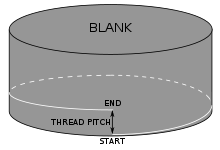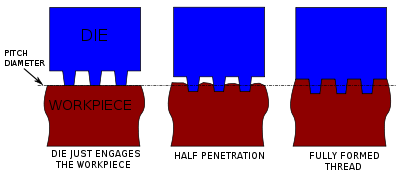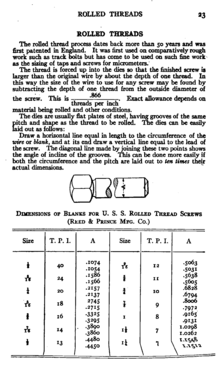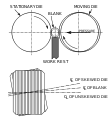- Threading (manufacturing)
-
Threading is the process of creating a screw thread. More screw threads are produced each year than any other machine element.[1] There are many methods of generating threads, including subtractive methods (many kinds of thread cutting and grinding, as detailed below); deformative or transformative methods (rolling and forming; molding and casting); additive methods (such as 3D printing); or combinations thereof.
Contents
Overview of methods (comparison, selection, etc)
There are various methods for generating screw threads. The method chosen for any one application is chosen based on constraints—time; money; degree of precision needed (or not needed); what equipment is already available; what equipment purchases could be justified based on resulting unit price of the threaded part (which depends on how many parts are planned); etc.
In general, certain thread-generating processes tend to fall along certain portions of the spectrum from toolroom-made parts to mass-produced parts, although there can be considerable overlap. For example, thread lapping following thread grinding would fall only on the extreme toolroom end of the spectrum, while thread rolling is a large and diverse area of practice that is used for everything from microlathe leadscrews (somewhat pricey and very precise) to the cheapest deck screws (very affordable and with precision to spare).
Threads of metal fasteners are usually created on a thread rolling machine. They may also be cut with a lathe, tap or die. Rolled threads are stronger than cut threads, with increases of 10% to 20% in tensile strength and possibly more in fatigue resistance and wear resistance.[2][3]
Subtractive methods
Thread cutting
Thread cutting, as compared to thread forming and rolling, is used when full thread depth is required, when the quantity is small, when the blank is not very accurate, when threading up to a shoulder is required, when threading a tapered thread, or when the material is brittle.[4]
Taps and dies
Main articles: Tap and die and Die headA common method of threading is cutting with taps and dies. Unlike drill bits, hand taps do not automatically remove the chips they create. A hand tap cannot cut its threads in a single rotation because it creates long chips which quickly jam the tap (an effect known as "crowding"[citation needed]), possibly breaking it. Therefore, in manual thread cutting, normal wrench usage is to cut the threads 1/2 to 2/3 of a turn (180 to 240 degree rotation), then reverse the tap for about 1/6 of a turn (60 degrees) until the chips are broken by the back edges of the cutters. It may be necessary to periodically remove the tap from the hole to clear the chips, especially when a blind hole is threaded.
For continuous tapping operations (i.e., power tapping) specialized spiral point or "gun" taps are used to eject the chips and prevent crowding.
Single-point threading
Single-point threading, also colloquially called single-pointing (or just thread cutting when the context is implicit), is an operation that uses a single-point tool to produce a thread form on a cylinder or cone. The tool moves linearly while the precise rotation of the workpiece determines the lead of the thread. The process can be done to create external or internal threads (male or female). In external thread cutting, the piece can either be held in a chuck or mounted between two centers. With internal thread cutting, the piece is held in a chuck. The tool moves across the piece linearly, taking chips off the workpiece with each pass. Usually 5 to 7 light cuts create the correct depth of the thread.[5]
The coordination of various machine elements including leadscrew, slide rest, and change gears was the technological advance that allowed the invention of the screw-cutting lathe, which was the origin of single-point threading as we know it today.
Today engine lathes and CNC lathes are the commonly used machines for single-point threading. On CNC machines, the process is quick and easy (relative to manual control) due to the machine's ability to constantly track the relationship of the tool position and spindle position (called "spindle synchronization"). CNC software includes "canned cycles", that is, preprogrammed subroutines, that obviate the manual programming of a single-point threading cycle. Parameters are entered (e.g., thread size, tool offset, length of thread), and the machine does the rest.
All threading could feasibly be done using a single-point tool, but because of the high speed and thus low unit cost of other methods (e.g., tapping, die threading, and thread rolling and forming), single-point threading is usually only used when other factors of the manufacturing process happen to favor it (e.g., if only a few threads need to be made,[6] if an unusual or unique thread is required,[6] or if there is a need for very high concentricity with other part features machined during the same setup[7]).
Thread milling
Threads may be milled with a rotating milling cutter if the correct helical toolpath can be arranged. This has been possible mechanically since the early nineteenth century, but it was never a commonplace method of threading until the widespread dissemination of affordable, fast, precise CNC. Since that development, internal and external threads are often milled. Some advantages of thread milling, as compared to single-point cutting, are a better surface finish; improved concentricity in some cases; and that a left- or right-hand thread can be created with the same tool.[8] Additionally, for large, awkward workpieces (such as a fire hydrant casting), it is simply easier to let the workpiece sit stationary on a table while all needed machining operations are performed on it with rotating tools, as opposed to rigging it up for rotation around the axis of each set of threads (that is, for the "arms" and "mouth" of the hydrant).
There are various types of thread milling, including several variants of form-milling and a combination of drilling and threading with one cutter, called thrilling.
Form-milling uses either a single- or multiple-form cutter. In one variant of form-milling, the single-form cutter is tilted to the helix angle of the thread and then fed radially into the blank. The blank is then slowly rotated as the cutter is precisely moved along the axis of the blank, which cuts the thread into the blank. This can be done in one pass, if the cutter is fed to the full thread depth, or in two passes, with the first not being to the full thread depth. This process is mainly used on threads larger than 1.5 in (38 mm). It is commonly used to cut large-lead or multiple-lead threads. A similar variant using a multiple-form cutter exists, in which the process completes the thread in one revolution around the blank. The cutter must be longer than the desired thread length. Using a multiple-form cutter is faster than using a single-form cutter but it is limited to threads with a helix angle less than 3°. It is also limited to blanks of a substantial diameter and no longer than 2 in (51 mm).[9]
Another variant of form-milling involves holding the cutter's axis orthogonally (no canting to the thread's helix angle) and feeding the cutter in a toolpath that will generate the thread.[10] The part is usually a stationary workpiece, such as a boss on a valve body (in external thread milling) or a hole in a plate or block (in internal thread milling). This type of thread milling uses essentially the same concept as contouring with an endmill or ball-nose mill, but the cutter and toolpath are arranged specifically to define the "contour" of a thread. The toolpath is achieved either using helical interpolation (which is circular interpolation in one plane [typically XY] with simultaneous linear interpolation along a third axis [typically Z]; the CNC control model must be one that supports using the third axis)[10] or a simulation of it using extremely small increments of 3-axes linear interpolation (which is not practical to program manually but can be programmed easily with CAD/CAM software).[11] The cutter geometry reflects the thread pitch but not its lead; the lead (thread helix angle) is determined by the toolpath.[12] Tapered threads can be cut either with a tapered multiple-form cutter that completes the thread in one revolution using helical interpolation,[13] or with a straight or tapered cutter (of single- or multiple-form) whose toolpath is one or more revolutions but cannot use helical interpolation and must use CAD/CAM software to generate a contour-like simulation of helical interpolation.[13]
The tooling used for thread milling can be solid or indexable. For internal threads, solid cutters are generally limited to holes larger than 6 mm (0.24 in),[12] and indexable internal thread cutting tools are limited to holes larger than 12 mm (0.47 in). The advantage is that when the insert wears out it is easily and more cost effectively replaced. The disadvantage is the cycle time is generally longer than solid tools. Note that solid multiple-form thread cutting tools look similar to taps, but they differ in that the cutting tool does not have a backtaper and there is not a lead-in chamfer. This lack of a lead-in chamfer allows the threads to be formed within one pitch length of the bottom of a blind hole.[14]
Thrilling
Thrilling is the process of drilling and threading internal threads using a specialized cutting tool on a CNC mill. The cutting tool tip is shaped like a drill, while the shank has a thread shaped form. The cutter first plunges to drill the hole. Then the thread is circularly interpolated just like the multiple-form cutter described above. The advantage is this process eliminates a tool, tool holder, and tool change. The disadvantage is that the process is limited to hole depth no greater than three times the diameter of the tool.[15]
Thread grinding
Thread grinding is done on a grinding machine using specially dressed grinding wheels matching the shape of the threads. The process is usually used to produce accurate threads or threads in hard materials; a common application is ball screw mechanisms.[citation needed] There are three types: center-type grinding with axial feed, center-type infeed thread grinding and centerless thread grinding. Center-type grinding with an axial feed is the most common of the three. It is similar to cutting a thread on a lathe with a single-point cutting tool, except the cutting tool is replaced with a grinding wheel. Usually a single ribbed wheel is used, although multiple ribbed wheels are also available. To complete the thread multiple passes are commonly required. Center-type infeed thread grinding use a grinding wheel with multiple ribs that is longer than the length of the desired thread. First, the grinding wheel is fed into the blank to the full thread depth. Then the blank is slowly rotated through approximately 1.5 turns while axially advancing through one pitch per revolution. Finally, the centerless thread grinding process is used to make head-less set screws in a similar method as centerless grinding. The blanks are hopper-fed to the grinding wheels, where the thread is fully formed. Common centerless thread grinding production rates are 60 to 70 pieces per minute for a 0.5 in (13 mm) long set screw.[15]
Thread lapping
Rarely, thread cutting or grinding (usually the latter) will be followed by thread lapping in order to achieve the highest precision and surface finish achievable. This is a toolroom practice when the highest precision is required, rarely employed except for the leadscrews or ballscrews of high-end machine tools.
Threading with EDM
Internal threads can be electrical discharge machined (EDM) into hard materials using a sinker style machine.
Deformative or transformative methods
Thread forming and rolling
Thread forming and thread rolling are processes for forming screw threads, with the former referring to creating internal threads and the latter external threads. In both of these processes threads are formed into a blank by pressing a shaped die against the blank, in a process similar to knurling. These processes are used for large production runs because typical production rates are around one piece per second. Forming and rolling produce no swarf and less material is required because the blank size starts smaller than a blank required for cutting threads; there is typically a 15 to 20% material savings in the blank, by weight.[15] A rolled thread can often be easily recognized because the thread has a larger diameter than the blank rod from which it has been made; however, necks and undercuts can be cut or rolled onto blanks with threads that are not rolled. Also, the end of the screw usually looks a bit different from the end of a cut-thread screw.[3]
Materials are limited to ductile materials because the threads are cold formed. However, this increases the thread's yield strength, surface finish, hardness, and wear resistance.[15] Also, materials with good deformation characteristics are necessary for rolling; these materials include softer (more ductile) metals and exclude brittle materials, such as cast iron. Tolerances are typically ±0.001 in. (±0.025 mm), but tolerances as tight as ±0.0006 in (±0.015 mm) are achievable. Surface finishes range from 6 to 32 micro-inches.[16]
There are four main types of thread rolling, named after the configuration of the dies: flat dies, two-die cylindrical, three-die cylindrical, and planetary dies. The flat die system has two flat dies, the bottom one is held stationary and the other slides. The blank is placed on one end of the stationary die and then the moving die slides over the blank, which causes the blank to roll between the two dies forming the threads. Before the moving die reaches the end of its stroke the blank rolls off the stationary die in a finished form. The two-die cylindrical process is used to produce threads up to 6 in (150 mm) in diameter and 20 in (510 mm) in length. There are two types of three-die processes; the first has the three dies move radially out from the center to let the blank enter the dies and then closes and rotates to roll the threads. This type of process is commonly employed on turret lathes and screw machines. The second type takes the form of a self-opening die head. This type is more common than the former, but is limited by not being able form the last 1.5 to 2 threads against shoulders. Planetary dies are used to mass produce threads up to 1 in (25 mm) in diameter.[4][15]
Thread forming is performed using a fluteless tap, or roll tap,[17] which closely resembles a cutting tap without the flutes. There are lobes periodically spaces around the tap that actually do the thread forming as the tap is advanced into a properly sized hole. Since the tap does not produce chips, there is no need to periodically back out the tap to clear away chips, which, in a cutting tap, can jam and break the tap. Thus thread forming is particularly suited to tapping blind holes, which are tougher to tap with a cutting tap due to the chip build-up in the hole. Note that the tap drill size differs from that used for a cutting tap and that an accurate hole size is required because a slightly undersized hole can break the tap. Proper lubrication is essential because of the frictional forces involved, therefore a lubricating oil is used instead of cutting oil.[2][4]
When considering the blank diameter tolerance, a change in blank diameter will affect the major diameter by an approximate ratio of 3 to 1. Production rates are usually three to five times faster than thread cutting.[citation needed]
Tool styles Description Application Flat dies Machine, tapping and wood screws Cylindrical in-feed 2 dies Large or balanced screws Cylindrical in-feed 3 dies Tube fitting, spark plugs Planetary dies High volumes screws, sheet metal screws, and drive screws Production rates[5][16] Thread diameter [in.] Flat dies [pieces/min] Cylindrical [pieces/min] Planetary [pieces/min] 1/8 40 to 500 75 to 300 450 to 2000 1/4 40 to 400 60 to 150 250 to 1200 1/2 25 to 90 50 to 100 100 to 400 3/4 20 to 60 5 to 10 - 1 15 to 50 1 to 50 - Thread casting and molding
In casting and molding the threads are directly formed by the geometry of the mold cavity in the mold or die. When the material freezes in the mold, it retains the shape after the mold is removed. The material is heated to a liquid, or mixed with a liquid that will either dry or cure (such as plaster or cement). Alternately, the material may be forced into a mold as a powder and compressed into a solid, as with graphite.
Although the first thoughts that come to mind for most machinists regarding threading are of thread cutting processes (such as tapping, single-pointing, or helical milling), Smid points out that, when plastic bottles for food, beverages, personal care products, and other consumer products are considered, it is actually plastic molding that is the principal method (by sheer volume) of thread generation in manufacturing today.[18] Of course, this fact highlights the importance of the moldmakers getting the mold just right (in preparation for millions of cycles, usually at high speed).
Cast threads in metal parts may be finished by machining, or may be left in the as-cast state. (The same can be said of cast gear teeth.) Whether or not to bother with the additional expense of a machining operation depends on the application. For parts where the extra precision and surface finish is not strictly necessary (although it might be nice), the machining is forgone in order to achieve a lower cost. With sand casting parts this means a rather rough finish; but with molded plastic or die-cast metal, the threads can be very nice indeed straight from the mold or die. A common example of molded plastic threads is on soda (pop) bottles. A common example of die-cast threads is on cable glands (connectors/fittings).
Additive methods
Many, perhaps most, threaded parts have potential to be generated via additive manufacturing, of which there are many variants, including fused deposition modeling, direct metal laser sintering, 3D printing, solid freeform fabrication, layered object manufacturing, and stereolithography. Most additive technologies are still on the laboratory end of their historical development, but further commercialization is picking up speed. Additive methods today generally produce a rough surface finish, which suggests that their earliest commercial wins will be in parts that don't require secondary finishing by subtractive methods.
Combinations of subtractive, additive, deformative, or transformative methods
Often subtractive, additive, deformative, or transformative methods are combined in whatever ways are advantageous. Such multidisciplinary manufacturing falls under classifications including rapid prototyping, desktop manufacturing, direct manufacturing, direct digital manufacturing, digital fabrication, instant manufacturing, or on-demand manufacturing.
Inspection
Inspection of the finished screw threads can be achieved in various ways, with the expense of the method tailored to the requirements of the product application. Shop-floor inspection of a thread is often as simple as running a nut onto it (for male threads) or a bolt into it (for female threads). This is plenty good enough for many applications (e.g., MRO or hobbyist work), although it is not good enough for most commercial manufacturing. Higher-precision methods are discussed below.
Commercial-grade inspection of screw threads can involve most of the same inspection methods and tools used to inspect other manufactured products, such as micrometers; vernier or dial calipers; surface plates and height gauges; gauge blocks; optical comparators; white light scanners; and coordinate-measuring machines (CMMs). Even industrial radiography (including industrial CT scanning) can be used, for example, to inspect internal thread geometry in the way that an optical comparator can inspect external thread geometry.
Conical micrometer anvils, specifically suited to resting on the sides of the thread, are made for various thread angles, with 60° being the most common. Mics with such anvils are usually called "thread mics". Users who lack thread mics rely instead on the "3-wire method", which involves placing 3 short pieces of wire (or gauge pins) of known diameter into the valleys of the thread and then measuring from wire to wire with standard (flat) anvils. A conversion factor (produced by a straightforward trigonometric calculation) is then multiplied with the measured value to infer a measurement of the thread's pitch diameter. Tables of these conversion factors were established many decades ago for all standard thread sizes, so today a user need only take the measurement and then perform the table lookup (as opposed to recalculating each time). The 3-wire method is also used when high precision is needed to inspect a specific diameter, commonly the pitch diameter, or on specialty threads such as multi-start or when the thread angle is not 60°. Ball-shaped micrometer anvils can be used in similar fashion (same trigonometric relationship, less cumbersome to use). Digital calipers and micrometers can send each measurement datum as it occurs through an interface (commonly RS-232) to storage and as input to software, in which case the table lookup is done in an automated way, and quality assurance and quality control can be achieved using statistical process control.
History
Each method of thread generation has its own detailed history. Therefore a comprehensive discussion is beyond the scope of this article; but much historical information is available in related articles, including:
- Screw > History
- Screw-cutting lathe > History
- Automatic lathe > History
- Screw thread > History of standardization
- Turret lathe [various sections]
- Casting (metalworking) and its family of articles (e.g., Sand casting > History)
- Grinding (abrasive cutting) and its family of articles
- Additive manufacturing > Historical development and broadening applications
- Various specific additive manufacturing articles (e.g., digital fabricator, direct digital manufacturing, 3D printing, rapid prototyping, solid freeform fabrication)
- List of emerging technologies
References
- ^ Degarmo, Black & Kohser 2003, p. 741.
- ^ a b Green 1996, pp. 1828–1830.
- ^ a b Green 1996, p. 1842
- ^ a b c Degarmo, Black & Kohser 2003, p. 758.
- ^ a b Todd, Allen & Alting 1994, pp. 149–150.
- ^ a b http://www.madehow.com/Volume-3/Screw.html Accessed on January 11, 2009
- ^ Sherline (1996). "Sherline End Mill Holders". Instructions for Using Milling Machine Accessories. Sherline. http://www.sherline.com/3079inst.htm. Retrieved 2010-02-25.
- ^ Degarmo, Black & Kohser 2003, p. 755.
- ^ Degarmo, Black & Kohser 2003, p. 754.
- ^ a b Smid 2008, pp. 433–442.
- ^ Smid 2008, p. 443.
- ^ a b Smid 2008, p. 435.
- ^ a b Smid 2008, p. 442.
- ^ Stephenson & Agapiou 2006, pp. 235–236.
- ^ a b c d e Degarmo, Black & Kohser 2003, p. 756.
- ^ a b Todd, Allen & Alting 1994, p. 324.
- ^ Stephenson & Agapiou 1997, p. 260.
- ^ Smid 2008.
Bibliography
- Degarmo, E. Paul; Black, J T.; Kohser, Ronald A. (2003), Materials and Processes in Manufacturing (9th ed.), Wiley, ISBN 0-471-65653-4.
- Green, Robert E. et al. (eds) (1996), Machinery's Handbook (25 ed.), New York, NY, USA: Industrial Press, ISBN 978-0-8311-2575-2, http://www.worldcat.org/title/machinerys-handbook/oclc/473691581.
- Smid, Peter (2008), CNC Programming Handbook (3rd ed.), New York: Industrial Press, ISBN 9780831133474, LCCN 2007-045901.
- Stephenson, David A.; Agapiou, John S. (1997), Metal cutting theory and practice, Marcel Dekker, ISBN 9780824795795, http://books.google.com/books?id=19AdVu1O4fQC.
- Stephenson, David A.; Agapiou, John S. (2006), Metal cutting theory and practice (2nd ed.), CRC Press, ISBN 9780824758882, http://books.google.com/books?id=PvK72Ymaj10Cpg=PA235.
- Todd, Robert H.; Allen, Dell K.; Alting, Leo (1994), Manufacturing Processes Reference Guide, Industrial Press Inc., ISBN 0-8311-3049-0, http://books.google.com/books?id=6x1smAf_PAcC.
Further reading
- Colvin, Fred H. (1947), Sixty Years with Men and Machines, New York and London: McGraw-Hill, LCCN 47-003762. Available as a reprint from Lindsay Publications (ISBN 978-0-917914-86-7). Foreword by Ralph Flanders.
- Roe, Joseph Wickham (1916), English and American Tool Builders, New Haven, Connecticut, USA: Yale University Press, LCCN 16-011753, http://books.google.com/books?id=X-EJAAAAIAAJ&printsec=titlepage. Reprinted by McGraw-Hill, New York and London, 1926 (LCCN 27-024075); and by Lindsay Publications, Inc., Bradley, IL, USA (ISBN 978-0-917914-73-7).
- Roe, Joseph Wickham (1937), James Hartness: A Representative of the Machine Age at Its Best, New York, New York, USA: American Society of Mechanical Engineers, LCCN 37-016470; OCLC 3456642, http://www.worldcat.org/oclc/3456642.
- Rybczynski, Witold (2000), One good turn: a natural history of the screwdriver and the screw, Scribner, ISBN 978-0-684-86729-8, OCLC 462234518, LCCN 00-036988. Various republications (paperback, e-book, braille, etc).
External links
Categories:
Wikimedia Foundation. 2010.









